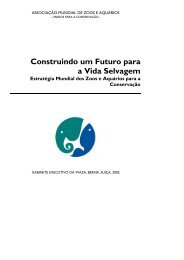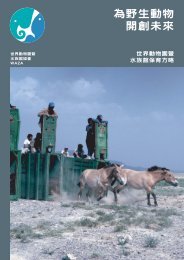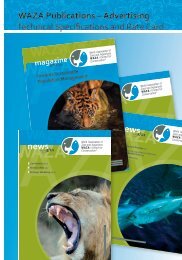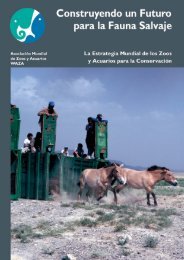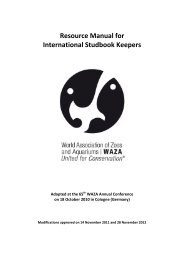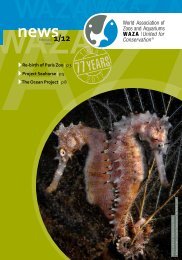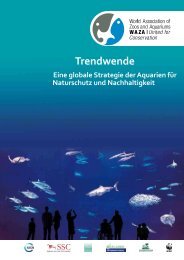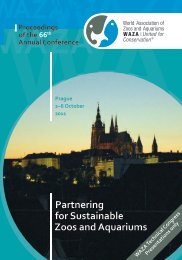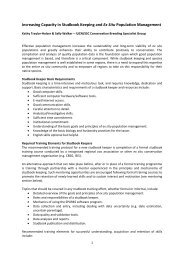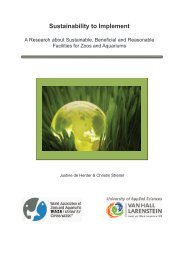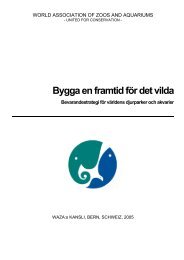Fighting Extinction - Waza
Fighting Extinction - Waza
Fighting Extinction - Waza
You also want an ePaper? Increase the reach of your titles
YUMPU automatically turns print PDFs into web optimized ePapers that Google loves.
32 Père David’s Deer<br />
WAZA magazine Vol 13/2012<br />
»<br />
In 2010 the Environmental Protection<br />
Bureau appointed a partnership<br />
comprising of Maja Boyd (who had<br />
stayed closely involved with the species),<br />
Woburn Deer Park (recognised<br />
experts in milu management and<br />
historically one of the main reasons<br />
why the species has survived), the<br />
Wetlands and Wildfowl Trust (for<br />
their skills in designing an optimising<br />
habitat conditions for the milu)<br />
and Bristol Zoo Gardens (for their<br />
expertise in working with local communities<br />
living around protected<br />
areas in situations of human–wildlife<br />
conflict) to develop a 15-year master<br />
plan for the area – now entitled the<br />
Hubei Shishou Milu National Nature<br />
Reserve (Hubei Environmental<br />
Protection Bureau 2011). The plan<br />
was presented in November 2011 to<br />
a panel of Chinese experts, headed<br />
by academician Jin Jianming who ratified<br />
the strategy and implementation<br />
plan. There are currently around 450<br />
milu living inside the Reserve, with<br />
an estimated 350 more living freely<br />
in Hubei and Hunan. The species has<br />
most certainly been re-established in<br />
its former range.<br />
Future Plans<br />
What now for the milu in China?<br />
Although still classified as Extinct in<br />
the Wild, this is clearly incorrect, as<br />
the authors have seen and photographed<br />
individual animals outside of<br />
any contained herd. Students of the<br />
Central South University of Forestry<br />
and Technology at Changsha have<br />
also followed three wild-living populations<br />
in Hubei and Hunan. As well as<br />
these wild herds, there are now many<br />
zoos in China that hold at least a few<br />
individuals. What is clearly needed<br />
now is an agreed Conservation Action<br />
and Management Plan (CAMP), so<br />
that the species can be managed<br />
on a country-wide scale, benefiting<br />
from the lessons learned over the last<br />
120 years. Zhang Linyuan, director<br />
of the Beijing Biodiversity Research<br />
Centre at Nan Haizi, believes that the<br />
species would benefit from a coming<br />
together of recognised experts in<br />
milu conservation, from within China<br />
as well as internationally, and as such<br />
is looking at the potential of hosting<br />
a CAMP workshop sometime in 2013,<br />
so that such a national plan can be<br />
agreed and implemented.<br />
It is an exciting prospect and will give<br />
the opportunity for individuals and<br />
organisations to celebrate one of the<br />
few major success stories in wildlife<br />
conservation, whilst recognising that<br />
there is still work to be done, especially<br />
as wild populations increase and<br />
come into conflict with human activities.<br />
With so many species under the<br />
threat of imminent extinction, the<br />
milu workshop will indeed be a rare<br />
event – management planning of an<br />
animal that was so very nearly lost to<br />
the world and is now on the increase.<br />
The role of zoos and private collections<br />
in safeguarding this species<br />
from extinction is something that all<br />
zoo professionals should be proud of.<br />
References<br />
• Beck, B. B. & Wemmer, C. M.<br />
(1983) The Biology and Management<br />
of an Extinct Species: Père<br />
David’s Deer. Park Ridge: Noyes<br />
Publications.<br />
• Boyd, M. M. & Zongyi, Wang<br />
(1989) The reintroduction of Père<br />
David’s deer (Elaphurus davdianus)<br />
to Nan Haizi Milu Reserve,<br />
Beijing, China. Proceedings of<br />
the Fifth International Theriological<br />
Congress, Rome.<br />
• Fox, H. M. (1949) Abbé David’s<br />
Diary. Cambridge: Harvard<br />
University Press.<br />
• Hubei Environmental Protection<br />
Bureau (2011) Hubei Shishou Milu<br />
National Nature Reserve: Master<br />
Plan for Development 2011–2026.<br />
Wuhan: Hubei Environmental<br />
Protection Bureau.<br />
• Zeng, Y., Jiang, Z. & Li, C. (2007)<br />
Genetic variability in relocated<br />
Père David’s deer (Elaphurus<br />
davidianus) populations – Implications<br />
to reintroduction program.<br />
Conservation Genetics 8:<br />
1051–1059.



